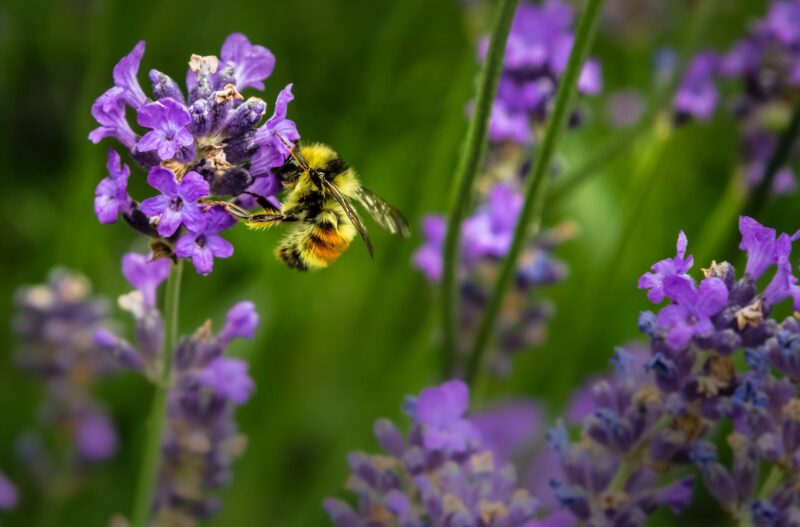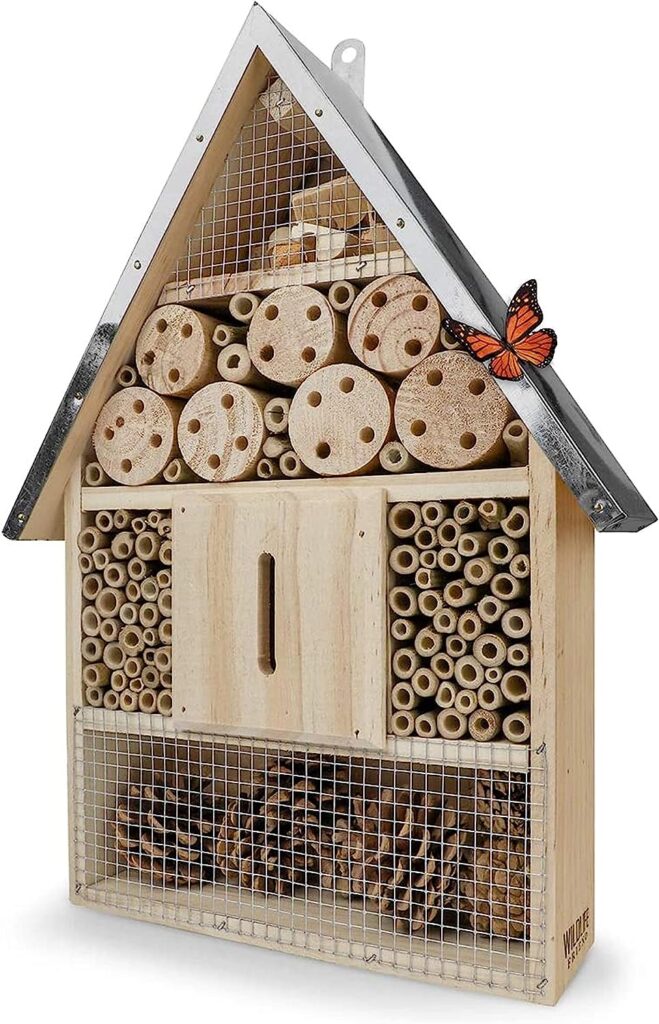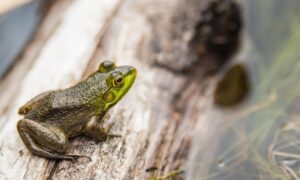We independently research, review, and recommend the best products. If you buy something through our links, we may earn a commission. Learn more.
Bees are some of the most important creatures in our ecosystem, and as gardeners, it’s our duty to support and protect these amazing insects. In the UK alone, there are over 270 species of bees, each with their own preferences regarding food and habitat.
You can do your bit by creating a garden that provides everything bees need to thrive. In this article, I’ll share my tips and tricks for attracting bees to your garden, so you can get your outdoor space buzzing with activity.
Contents
Plant Diverse Flowers
One of the best things you can do to attract bees is to bed a variety of plants. Bees have a varied diet, so you’ll want to plant a mix of annuals, perennials, and shrubs to provide a steady supply of nectar and pollen throughout the seasons for bees. A quick win is to add some fruiting plants, as these tend to flower before the berries appear, offering up a valuable food source for bees.
Of course, there are tons of plants you could choose to attract pollinators, but here are a few of my favourites:
Lupins

I adore these beauties! They produce spikes of flowers in shades of blue, purple, pink, and yellow that are so dramatic. Not only do they provide a feast for the eyes, but they are also a fantastic source of nectar and pollen for our buzzy friends. These flowers typically bloom from June to September, making them a great option if you want to set your garden alight with colour in the summer months.
When it comes to planting lupins, choose a spot with well-drained soil and full sun exposure. They can grow quite tall, so I like to place them towards the back of my flower beds. For those looking to add some extra pizzazz, try planting lupins in groups of three or five—they’ll create a stunning display come summer.
Salvias

Next up, we have Salvias—an eye-catching perennial that boasts brightly-coloured red, blue, purple and pink spikes. These are an absolute must-have for anyone looking to attract pollinators from June to October—taking on the name ‘bee’s bliss’ for a very good reason. They’re pretty drought-tolerant, which is good if you want to plant them in drifts alongside bright greens. To keep these plants looking their best, don’t be afraid to pinch back the tips to encourage bushier growth.
Campanulas

These are bell-shaped flowers that bloom in shades of blue, purple, and white. Bees are drawn to their sweet nectar, making them a valuable addition to your garden from June to September (these plants are known for having a long flowering season). I’ve found Campanulas work best for those with a cottage-garden scheme, or spaces with an informal herbaceous border, as they spill onto paths.
When planting Campanulas, make sure to choose a spot with well-drained soil and partial-to-full sun exposure. They can be prone to sprawling, so consider staking them or planting them in containers if you have limited garden space.
Agapanthus

Agapanthus—another one of my favourite flowers! These plants produce gentle blossoms and a soothing fragrance that bees adore. They bloom in blue or white — two colours that are most visible for bees, so they naturally make a ‘beeline’ (sorry) for Agapanthus when it’s grown among green vegetation. They also pack tons of pollen.
You’ll find these flowers blooming from June to September, so you’ll want to plant Agapanthus in a spot with full sun exposure. They can grow quite large, so I recommend giving them plenty of breathing space to spread out.
African Daisies

Finally, we have African Daisies, a bright and cheerful annual that never fails to bring a smile to my face. My favourite variety is Cape marguerite (Osteospermum ecklonis), also known as ‘Sunday’s River Daisy’, which blooms in white or purple flowers that always stops bees in their tracks. It’s worth noting that these flowers don’t supply as much pollen as some of the other varieties in this list, but they do attract bees due to their colour.
African Daisies are incredibly easy to care for and will grow in almost any type of soil—blooming from May to November. I always like to use them for cut flower arrangements, so don’t be afraid to snip a few blooms and bring them indoors to brighten up your living space.
Create Colour
Creating a colourful garden is key to attracting a variety of pollinators. Whether it’s the soft pinks of an English Rose, or the bold, bright reds of a bed of geraniums, the right combination of colours will get your garden bustling with life.
When it comes to attracting pollinators, it’s all about creating a visual feast. Different insects are attracted to different colours, so it’s important to offer a variety of hues to attract a broad range of bees, butterflies, and other insects.
Bees, for example, are particularly drawn to blue, purple, and yellow flowers, so planting a selection of lavenders, borage, and sunflowers is a great way to keep these important pollinators busy. Meanwhile, butterflies tend to prefer white and pink blooms, so planting some sweet alyssum, butterfly bushes, and phlox will keep these delicate creatures flitting about your garden.
But don’t just stop there. Mix it up a little! There’s nothing wrong with planting a bed of red poppies to attract some hummingbirds, or creating a wildflower meadow filled with a mix of yellow and purple flowers to encourage pollinators. The more diverse your colour scheme, the more diverse your pollinator visitors.
And remember, planting flowers with different blooming seasons will also ensure that you have a steady stream of pollinators visiting your garden throughout the growing season.
Provide Shelter for Bees
Solitary bees, in particular, need a place to lay their eggs. They prefer to nest in small holes and crevices, so you could create a bee hotel using various materials. A simple solution is to drill holes of different diameters into a piece of wood and stack them in a sheltered spot. You could also use bamboo canes, hollow stems, and even rolled-up cardboard tubes. I’ve tried using piles of logs, which seem to work nicely.
Another option is to install a pre-made bee hotel. These can be purchased from garden centres or online, and they come in various shapes and sizes to suit different bee species. Just make sure to place your bee hotel in a sheltered spot that receives some sunlight, protected from strong winds and heavy rain.
Remember to keep your bee hotel clean and well-maintained. Every couple of years, remove any old nesting materials and replace them with fresh ones to encourage more bees to take up residence.
This bee hotel from Wildlife Friend is perfect for less than £40!
Another option is to create a wildflower meadow with a range of habitats for both solitary and social bees. By allowing areas of your garden to grow wild, you’ll provide a wealth of food and shelter. You could also consider planting various flowering shrubs and trees, such as lavender, rosemary, and hawthorn—these offer a lovely shelter from the elements.
Plant Winter-Flowering Plants

While bees are most active during the warmer months, they may still emerge on mild days in search of food. So planting some winter-flowering plants will provide a source of nectar and pollen for bees during the colder months.
Fatsia Japonica is a great winter-blooming shrub, producing clusters of white, star-shaped flowers that bees love. This hardy plant is also great for providing structure to your garden, boasting glossy green leaves and an architectural form.
Another excellent winter-flowering plant is English Ivy. The small yellow flowers that appear in late autumn are a valuable source of nectar for foraging bees, and the dense foliage can offer protection from the elements for those that need a place to overwinter.
Another excellent choice for winter-flowering plants is the Mahonia, which produces fragrant yellow flowers from November to March. These blooms are a lifesaver for hungry bees, as is winter heather, witch hazel, and winter jasmine. All of these plants produce early blooms that provide a welcome source of food for bees and other pollinators when the mercury drops.
Creating a Bee-Friendly Balcony or Patio
If you don’t have a garden, fret not: you can still create a welcoming environment for bees on your balcony or patio. Start by choosing container plants that are suitable for your local climate and provide a source of nectar and pollen for bees. Then you could consider adding a small bee hotel or a shallow dish of water with pebbles.
Also consider the amount of sunlight your balcony or patio receives. Bees are attracted to sun-loving plants, so if you have a warm spot, consider planting lavender, rosemary, and heather, that bloom at different times of year. These plants not only provide food for bees, but also add fragrance and colour to your space. If your balcony or patio is shaded, you can still create a bee-friendly space by planting various shade-tolerant species, such as ferns, hostas, and violets—all of which offer shelter on cooler days.
Consider adding a shallow water dish, small fountain or bird bath. You can even plant a shallow-rooted water-loving plant, such as watercress, to provide a source of moisture for bees and other pollinators.
Other Ways to Support Bees
According to a recent report, several species of bee in the U.K. are at risk of extinction due to habitat loss and disease. As horticulturists, we have the opportunity to make a difference by creating bee-friendly gardens and supporting the efforts to protect these important insects.
Here are a few other things you can do to support the bees in your garden:
- Avoid using pesticides, as these can harm bees and other pollinators.
- Support local beekeepers by purchasing local honey and other bee-related products.
By following the tips outlined above, you can create a beautiful and welcoming garden for bees and other pollinators.







